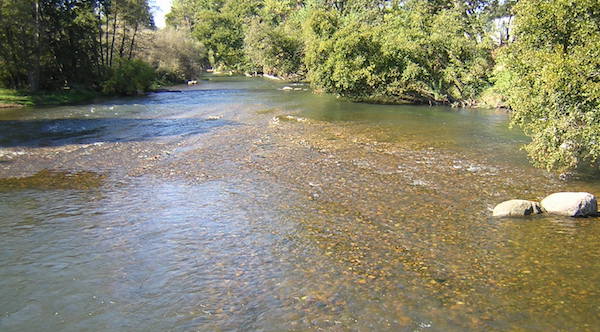Spawning Habitat Rehabilitation
What is SHR?

- Spawning habitat rehabilitation (SHR) is an effort undertaken by people to return a river to a more ecologically functional state compared to the degraded state that has developed over decades of negative impacts from human intervention.
- In the western U.S. context, SHR aims to maintain wild Pacific salmonid populations on regulated rivers by bringing back critical channel features and the associated fluvial processes that they create and in turn are rejuvenated by. SHR also seeks to enhance abiotic-biotic linkages in support of natural ecological functioning.
- SHR is intended to serve as one tool among many in river and catchment management, so it is not expected to achieve all imaginable goals- no approach can. Yet, in contrast with unproven theoretical ideal for optimizing entire catchments, SHR has been shown time and time again to work in achieving its transparent, limited goals.
Ecological Indicator
- SHR uses the salmon spawning life stage as an ecosystem indicator of a river's health and is based on the ecological concept of indicator species.
- The concept suggests that there exist species whose needs are similar to and reflect the needs of a broader group of species, and whose abundance is an indicator of ecosystem health.
- Thus, SHR focuses on improving spawning habitat, because such improvements can also yield benefits to fish during multiple life stages, macroinvertebrates and the entire aquatic food web. It also can benefit riparian species.
- By now it is well demonstrated that scientifically sound SHR projects do in fact bring widespread ecological and geomorphic benefits far beyond improving spawning habitat.
Types of SHR
There are typically 3 types of projects that constitute SRH.
| 1. Gravel/cobble injection | 2. Hydraulic structure placement | 3. Spawning riffle enhancement |
SHR Popularity
- SHR has been undertaken for several decades now, but science-based SRH has really only been going on since ~ 2000. The difference is that prior to ~ 2000, most projects were ad hoc, subjective efforts with no explicit use of the scientific method and little mindfulness of physical scientific reasoning.
- There is no official tally of how much has been spent on SHR, but it is widespread now.
- In the U.S., most dam relicensing efforts in salmonid-bearing streams require SRH in some form.
- The cost of SHR varies by method. When sediment can be sourced from a proximal quarry and placed by front loaders with easy access to the river, then it can be as low as ~ $20 per cubic meter. When placement sites are in remote canyons far form gravel sources and necessitating unusual, labor-intesive placement methods, then it can cost as much as ~ $100 per cubic meter.
